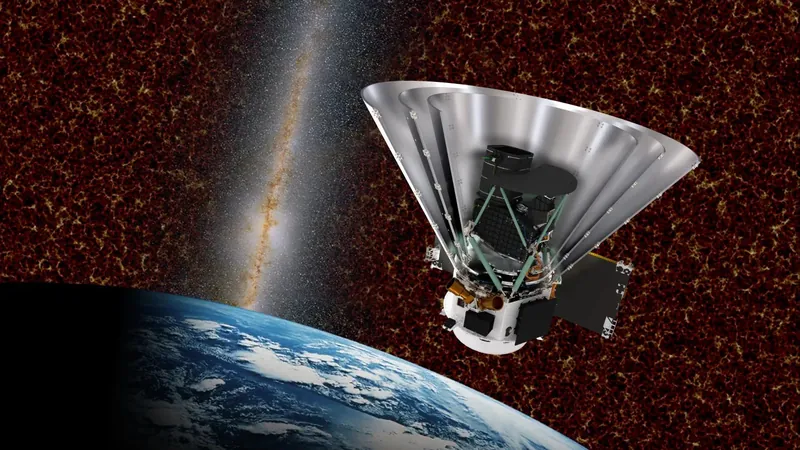
Exciting Space Missions Planned for 2025: From Private Space Stations to Lunar Exploration
2024-12-29
Author: John Tan
Exciting Space Missions Planned for 2025: From Private Space Stations to Lunar Exploration
As we inch closer to 2025, the landscape of space exploration is set for a groundbreaking evolution. Following a year marked by significant achievements including a return to the lunar surface and historic private astronaut journeys, the upcoming year promises to be equally thrilling. While substantive human missions to the moon may remain on hold, the ambit of space exploration will expand dramatically with a suite of uncrewed lunar missions and the launch of the first private space station.
SpaceX's Ambitious Starship Launches
Elon Musk's SpaceX is gearing up for an unprecedented increase in Starship test launches. The company plans to escalate its ambitions from five flight tests in 2024 to an astonishing 25 in 2025, pending regulatory approvals. Known as the world's most powerful rocket, the SpaceX Starship aims to facilitate crewed and uncrewed missions to Earth's orbit, the Moon, and beyond, setting the stage for humanity's aspirations in deep space exploration.
The seventh flight test of the 400-foot-tall Starship is already in the works, and while a specific launch date has yet to be confirmed, the anticipation is palpable within the space community.
Firefly Aerospace's Lunar Mission
In an exciting development, Firefly Aerospace has been awarded a $93.3 million NASA contract to send an uncrewed lander, named Blue Ghost, to the Moon. This mission, anticipated to launch no earlier than mid-January on a SpaceX Falcon 9 rocket, will carry 10 scientific payloads to investigate the Moon's environmental conditions—crucial data for future human return missions.
The Blue Ghost will land near Mons Latreille, within Mare Crisium, allowing scientists to gain insights into lunar subsurface features and assess how cosmic forces impact Earth. Looking further ahead, Firefly plans to conduct missions to the far side of the Moon, including deploying an orbiter satellite.
NASA's SPHEREx Telescope
Beyond lunar exploration, NASA is readying the sophisticated SPHEREx telescope to delve into the universe's origins. The mission, with a budget of $242 million, aims to survey hundreds of millions of galaxies and stars in our Milky Way, focusing on finding signs of water and organic molecules in areas where new planets are forming. This unprecedented exploration of cosmic origins will commence no earlier than late February 2025.
Boeing Starliner Returns via SpaceX
In an intriguing twist, Boeing's Starliner astronauts are set to return to Earth aboard a SpaceX Dragon vehicle after prolonged delays. Initially completed in June, the mission now sees astronauts Suni Williams and Butch Wilmore making their way back in late March, showcasing a novel collaboration in American space travel.
The Birth of the First Commercial Space Station
Excitingly, 2025 will mark the launch of the world's first commercial space station, Haven-1, orchestrated by Vast, a private company based in California. Slated to lift off in August, Haven-1 will initially serve as a standalone facility before being integrated into an expansive station plan expected to replace the International Space Station by 2028. Its first crewed exploration mission, Vast-1, will transport four astronauts to Deer-1 for a month-long orbital mission.
Intuitive Machines' Lunar Landing
Following their historic achievement as the first commercial entity to successfully land on the Moon, Intuitive Machines is set to launch a second lunar mission, IM-2, in 2025. Targeting the lunar south pole, this mission will be a collaboration with NASA's Lunar Trailblazer orbiter. Together, they will explore water ice deposits that may prove vital for future lunar settlements as part of NASA’s Artemis program.
Conclusion
With such a multi-faceted array of missions lined up, 2025 is gearing up to be a remarkable year in space exploration. As private companies step into roles traditionally held by government agencies, the door swings wide open for innovative discoveries and advancements that could define the future of human spaceflight. Buckle up—this cosmic journey is just getting started!
 Brasil (PT)
Brasil (PT)
 Canada (EN)
Canada (EN)
 Chile (ES)
Chile (ES)
 Česko (CS)
Česko (CS)
 대한민국 (KO)
대한민국 (KO)
 España (ES)
España (ES)
 France (FR)
France (FR)
 Hong Kong (EN)
Hong Kong (EN)
 Italia (IT)
Italia (IT)
 日本 (JA)
日本 (JA)
 Magyarország (HU)
Magyarország (HU)
 Norge (NO)
Norge (NO)
 Polska (PL)
Polska (PL)
 Schweiz (DE)
Schweiz (DE)
 Singapore (EN)
Singapore (EN)
 Sverige (SV)
Sverige (SV)
 Suomi (FI)
Suomi (FI)
 Türkiye (TR)
Türkiye (TR)
 الإمارات العربية المتحدة (AR)
الإمارات العربية المتحدة (AR)